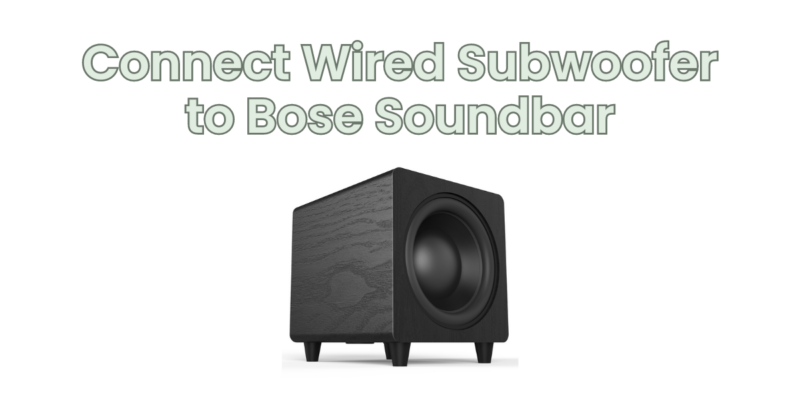Bose soundbars offer impressive audio quality and are a popular choice for home theater setups. If you’re looking to enhance the bass performance of your Bose soundbar, adding a wired subwoofer can greatly improve low-frequency sound reproduction. In this article, we will guide you through the process of connecting a wired subwoofer to a Bose soundbar.
- Check Compatibility: Before proceeding, ensure that your Bose soundbar supports the addition of a wired subwoofer. Some Bose soundbars come with a dedicated subwoofer output or proprietary connectors specifically designed for connecting a subwoofer. Review the specifications and documentation of your soundbar to confirm compatibility.
- Choose a Compatible Subwoofer: Select a wired subwoofer that is compatible with your Bose soundbar. Bose offers its own line of subwoofers designed to work seamlessly with their soundbars, such as the Bose Bass Module series. These subwoofers are engineered to deliver optimal bass performance and integrate well with Bose soundbar systems.
- Locate the Subwoofer Output: Check the back panel of your Bose soundbar to locate the subwoofer output or connector. Bose soundbars typically have dedicated ports labeled “Sub Out” or “Subwoofer Out.” This is where you will connect the subwoofer cable.
- Connect the Subwoofer Cable: Follow these steps to connect the subwoofer to the Bose soundbar:
a. Take the subwoofer cable that comes with the subwoofer or purchase a high-quality subwoofer cable separately.
b. Connect one end of the subwoofer cable to the subwoofer output on the back of the Bose soundbar.
c. Connect the other end of the subwoofer cable to the input port on the subwoofer. The port on the subwoofer is usually labeled “Line In” or “Subwoofer In.”
d. Ensure the connections are secure and tightly plugged in.
- Power On and Configure the Subwoofer: After connecting the subwoofer, power it on and follow the instructions provided in the subwoofer’s user manual to configure its settings. Some subwoofers have adjustable parameters, such as volume level, crossover frequency, and phase adjustment. Adjust these settings according to your preferences and the specific recommendations provided by the subwoofer manufacturer.
- Soundbar Configuration: To ensure the soundbar recognizes the subwoofer and properly routes the low-frequency audio signals, you may need to adjust the soundbar’s settings. Refer to your Bose soundbar’s user manual for instructions on accessing the configuration menu or settings.
a. Navigate to the soundbar’s settings menu using the included remote control or the Bose SoundTouch app, depending on the model.
b. Look for the option to enable the subwoofer or configure the bass settings. The exact steps may vary depending on your specific Bose soundbar model.
c. Follow the instructions provided in the manual to enable the subwoofer and adjust the bass settings to your preference.
- Test and Fine-Tune: After completing the setup, play various audio content to test the enhanced bass performance. Make sure the subwoofer is producing the desired impact and depth in the low-frequency sounds. If necessary, adjust the subwoofer’s volume level and the soundbar’s bass settings to achieve the desired balance.
By following these steps, you can connect a wired subwoofer to your Bose soundbar and enjoy enhanced bass performance in your home theater setup. The addition of a subwoofer will significantly enhance the overall audio experience, providing deeper and more impactful low-frequency reproduction.

